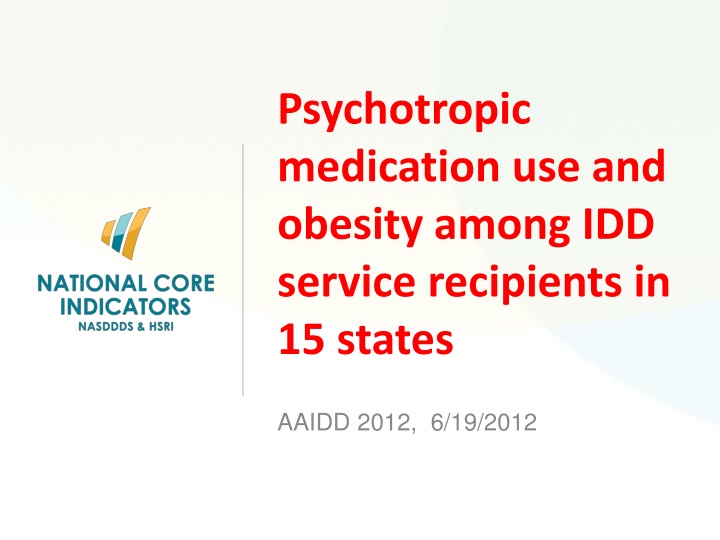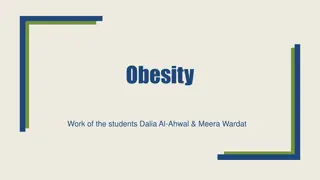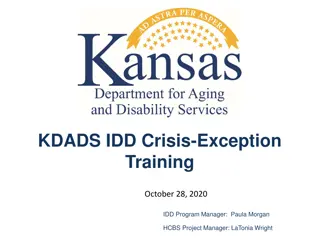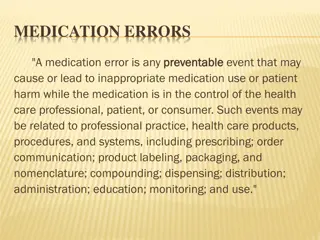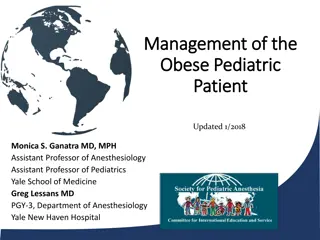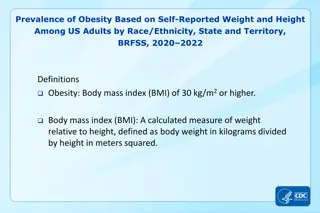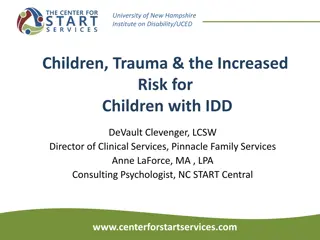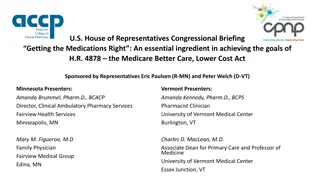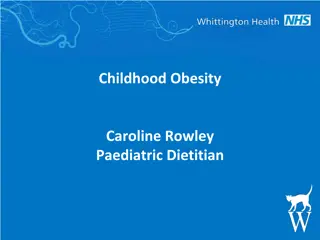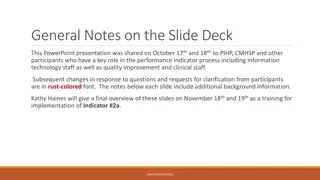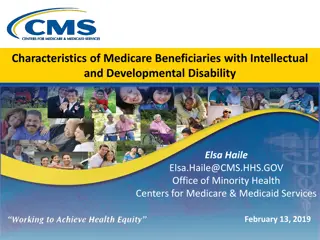Psychotropic Medication Use and Obesity Among IDD Service Recipients in 15 States
The National Core Indicators (NCI) is a multi-state collaboration focused on evaluating public systems for individuals with developmental disabilities. It includes various surveys and data collection methods to assess areas like employment, community inclusion, choice, rights, and health. Demographic findings reveal details about gender, living arrangements, age, race, ethnicity, and levels of intellectual disability among service recipients.
Download Presentation

Please find below an Image/Link to download the presentation.
The content on the website is provided AS IS for your information and personal use only. It may not be sold, licensed, or shared on other websites without obtaining consent from the author.If you encounter any issues during the download, it is possible that the publisher has removed the file from their server.
You are allowed to download the files provided on this website for personal or commercial use, subject to the condition that they are used lawfully. All files are the property of their respective owners.
The content on the website is provided AS IS for your information and personal use only. It may not be sold, licensed, or shared on other websites without obtaining consent from the author.
E N D
Presentation Transcript
Psychotropic medication use and obesity among IDD service recipients in 15 states AAIDD 2012, 6/19/2012
WHAT IS NCI? Multi-state collaboration of state DD agencies interested in measuring how well public systems for people with developmental disabilities perform along several areas, including: employment, community inclusion, choice, rights, and health and sa Launched in 1997 in 13 participating states Supported by participating states NASDDDS HSRI Collaboration NCI 2
WHAT IS NCI? Adult Consumer Survey Family Survey Adult Family Survey (person lives at home; 18 and older) Family Guardian Survey (person lives out-of-home; 18 and older) Children Family Survey (child lives at home; under 18 years old) Provider Survey Staff Stability System Data Mortality Incidents NCI 3
WHAT IS NCI? Adult Consumer Survey Standardized, face-to-face interview with a sample of individuals receiving services No pre-screening procedures Conducted with adults only (18 and over) receiving at least one service besides case management Takes 50 minutes on average Background section filled out by case managers and workers NCI 4
DATA Adult Consumer Survey, background section 2010-2011 data collection cycle 8,796 individuals 15 states NCI 5
FINDINGS Demographics Gender Where people live: 56% 44% 0% 5% 10% 15% 20% 25% 30% 35% 6% Specialized Institutional facility Average Age: 42.5 yrs 27% Group Home 4% Apartment Program 17% Independent Home/ Apt 34% Parent or Relative's home 6% Foster care/ Host home 1% Nursing Facility 4% Other 0% Don't know NCI 6
FINDINGS Demographics Race and Ethnicity 1%3% 1% 3% White 19% Black or African American Hispanic Asian Non-Hispanic Don't Know 77% Other race not listed 96% NCI 7
FINDINGS Demographics Level of ID 4% 7% No ID label Other Diagnoses Mild 12% Moderate 33% 36% 35% 14% Severe 30% 26% Profound 23% 27% 25% Don't know 20% 15% 15% 11%10% 10% 9% 8% 10% 3% 2% 5% 1% 0% NCI 8
FINDINGS Medications Takes medications for mood disorders: 38% Takes medications for anxiety: 29% Takes medications for behavior problems: 25% Takes medications for psychotic disorders: 18% Takes medications for at least one of the above: 53% NCI 9
FINDINGS Medications Of those who take medications for at least one condition/purpose, how many take meds for 1, 2, 3 and all 4 of them? 14% 39% 18% 1 purpose 2 purposes 3 purposes 29% N = 3,977 4 purposes Note: this is not the same as the number of medications taken. A person may take one medication for more than one purpose/condition. NCI 10
FINDINGS Medications and mental illness 49% of people who need support for behavior issues take meds for behavior problems Only 8% of people who do not need support for behavior issues take meds for behavior problems 88% of people with MI or a psychiatric disorder take meds for mood, anxiety, or psychotic disorders BUT 31% of people not diagnosed with MI or a psychiatric disorder also take meds for mood, anxiety, or psychotic disorders Meds for mood or anxiety disorder are more common w/o an MI dx than meds for psychotic disorder NCI 11
FINDINGS Characteristics of people who take meds Age At least one med: 43.3 years No meds: Diagnoses 41.5 years ASD 13% 6% CP Down Syndrome 10% 20% At least one med: No meds: 5% 13% Place of residence Institution Group home Indep home/apt 6% 35% 6% 19% Parent s 22% 47% At least one med: No meds: 18% 17% NCI 12
FINDINGS Obesity and medications Weight 6% Weight and meds 33% underweight 37% 35% 40% 32% normal 30% 29% 35% overweight 29% 28% 30% obese underweight 25% 29% normal 20% overweight 15% 62% overweight or obese obese 8% 10% 4% 5% 0% no meds at least one kind No meds: At least one med: 67% overweight or obese Odds ratio: 1.49 (p<0.001) 57% overweight or obese NCI 13
FINDINGS Obesity and medications BUT, personal characteristics (diagnoses, age, mobility) and place of residence may also affect weight, AND, may be related to whether a person is taking medications, SO, need risk-adjustment NCI 14
FINDINGS Obesity and medications Logistic regression Dependent variable: overweight or obese Independent variable: takes at least one med Controlling for: mobility, residence type, dx of ASD, dx of CP, dx of Down Syndrome, age All control variables are significant at 0.01 level After risk-adjustment: Odds ratio = 1.44 (p-value < 0.001) NCI 15
CONCLUSIONS 53% take at least one medication for mood/anxiety/behavior/psychotic disorders High percentage of people without an MI diagnosis still take these meds Those who take meds are more likely to live in group homes and less likely to live with parents or relatives Those who take meds are more likely to be diagnosed with ASD and less likely to be diagnosed with CP or Down Syndrome NCI 16
CONCLUSIONS 62% of people in the study are overweight or obese People who take at least one med are more likely to be overweight or obese This persists even after controlling for personal characteristics and place of residence (odds ratio of 1.44) NCI 17
CONTACT www.NationalCoreIndicators.org www.HSRI.org www.NASDDDS.org NCI 18
